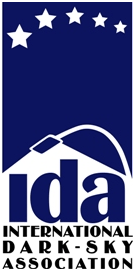International Dark-Sky Association

The International Dark-Sky Association (IDA) is a United States-based non-profit organization incorporated in 1988 by founders Dr David Crawford, a professional astronomer, and Dr Timothy Hunter, a physician/amateur astronomer. The mission of the IDA is "to preserve and protect the night time environment and our heritage of dark skies through quality outdoor lighting."[1] Light pollution is the result of outdoor lighting that is not properly shielded, allowing light to be directed into the eyes and the night sky. Light that shines into the eyes is called glare and light shining into the night sky above the horizon causes skyglow. Lighting can also cause light trespass when it is directed into areas that it is not wanted, e.g., a neighbor's yard and windows. IDA was the first organization in the dark-sky movement, and is currently the largest.
Principal approach
IDA's principal approach is to raise awareness about the value of dark, star-filled night skies and encourage their protection and restoration through education about the problems and solutions, including outdoor lighting practices that create less light pollution. In 2011, the organization had about 5,000 members in 70 countries.
Among many concerns, IDA and related organizations are collating research on light at night's (LAN) effects on human health and ecology as a result of artificial light at night. The hypothesis is that humans have evolved over millennia exposed to roughly equal periods of light and dark. The disruption of this circadian rhythm can cause hormone imbalance in all living organisms. In the last century, artificial lighting has reduced the regular period of darkness and may negatively impact health. Light at night has been linked to increased incidence of hypertension, attention deficit disorder, obesity, diabetes and some forms of cancer.[2]
International Dark Sky Places
To promote awareness about the issues, the IDA has an International Dark Sky Places program that aims "to protect locations of exceptional nighttime visages for future generations." [3]
International Dark Sky Parks
- Natural Bridges National Monument, Utah, United States, established 2006
- Cherry Springs State Park, Pennsylvania, United States, established 2008
- Galloway Forest Park, Scotland, United Kingdom, established 2009
- Zselic National Landscape Protection Area, Hungary, established 2009
- Clayton Lake State Park, New Mexico, United States, established 2010
- Goldendale Observatory State Park, Washington, United States, established 2010
- Hortobágy National Park, Hungary, established 2011
- The Headlands, Michigan, United States, established 2011
- Observatory Park, Ohio, United States, established 2011
- Big Bend National Park, Texas, United States, established 2012
- Death Valley National Park, California, United States, established 2013
- Chaco Culture National Historical Park, New Mexico, United States, established 2013
- Northumberland National Park, England, United Kingdom, established 2013
- Eifel National Park, Germany, established 2014
- Mayland Community College Blue Ridge Observatory and Star Park, United States, established 2014
- Grand Canyon-Parashant National Monument, United States, established 2014
- Hovenweep National Monument, Utah and Colorado, United States, established 2014[4]
International Dark Sky Reserves
- The Reserve at Mont-Mégantic, Quebec, Canada, established 2008
- Exmoor National Park, England, United Kingdom, established 2011
- NamibRand Nature Reserve, Namibia, Africa, established 2012
- Aoraki Mackenzie International Dark Sky Reserve, South Island, New Zealand, established 2012
- Brecon Beacons National Park, Wales, United Kingdom, established 2013
- Pic du Midi, France, established 2013
- Kerry International Dark-Sky Reserve, Kerry, Ireland, established 2014
- Westhavelland Nature Park, Germany, established 2014
International Dark Sky Communities
- Flagstaff, Arizona, United States, established 2001
- Borrego Springs, California, United States, established 2009
- Sark, Channel Islands, established 2011
- Homer Glen, Illinois, United States, established 2011
- Coll in the Inner Hebrides of Scotland, established 2013[5]
- Dripping Springs, Texas, United States, established 2014
- Beverly Shores, Indiana, United States, established 2014[6]
- Sedona, Arizona, United States, established 2014[7]
- Westcliffe/Silver Cliff, Colorado, United States, established 2015[8]
See also
- Bortle Dark-Sky Scale
- Campaign for Dark Skies (CfDS)
- CieloBuio, an Italian coordination for the protection of the night sky
- Dark-sky movement
- Dark-sky preserve
- Light pollution
- Sky brightness
References
- ↑ IDA Mission & Goals
- ↑ Stephen, M. Pauley (2004). "Lighting for the human circadian clock: recent research indicates that lighting has become a public health issue". Medical Hypotheses 63 (4): 588–596. doi:10.1016/j.mehy.2004.03.020. PMID 15325001.
- ↑ 'What is an International Dark Sky Place?', IDS Places
- ↑ "Hovenweep National Monument Named World's Newest International Dark Sky Park" (Press release). Tucson: SBWire. 2014-07-01. Retrieved 2014-07-14.
- ↑ "Isle of Coll secures 'dark isle' status". BBC News. 9 December 2013. Retrieved 9 December 2013.
- ↑ Keagle, Lauri Harvey (2014-06-25). "Beverly Shores named world's seventh Dark Sky Community". NWI Times. Retrieved 2014-06-25.
- ↑ Heinsius, Ryan (2014-08-05). "Sedona Becomes the Newest International Dark Sky Community". KNAU. Retrieved 2014-08-05.
- ↑ "Two Colorado Towns Come Together as Colorado’s First International Dark Sky Community status". IDA. 9 March 2015. Retrieved 9 March 2015.
External links
- www.darksky.org — official site
- International Dark-Sky Association's channel on YouTube
- flagstaffdarkskies.org — Flagstaff Dark Skies
- International Dark-Sky Association: Dark Sky Observing Sites & Destinations